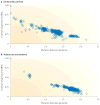Functional and evolutionary implications of gene orthology
- PMID: 23552219
- PMCID: PMC5877793
- DOI: 10.1038/nrg3456
Functional and evolutionary implications of gene orthology
Abstract
Orthologues and paralogues are types of homologous genes that are related by speciation or duplication, respectively. Orthologous genes are generally assumed to retain equivalent functions in different organisms and to share other key properties. Several recent comparative genomic studies have focused on testing these expectations. Here we discuss the complexity of the evolution of gene-phenotype relationships and assess the validity of the key implications of orthology and paralogy relationships as general statistical trends and guiding principles.
Conflict of interest statement
The authors declare no competing financial interests.
Figures


References
-
- Fitch WM. Distinguishing homologous from analogous proteins. Systemat Zool. 1970;19:99–106. - PubMed
-
- Fitch WM. Homology a personal view on some of the problems. Trends Genet. 2000;16:227–231. - PubMed
-
- Baldauf SL. Phylogeny for the faint of heart: a tutorial. Trends Genet. 2003;19:345–351. - PubMed
-
- Sonnhammer EL, Koonin EV. Orthology, paralogy and proposed classification for paralog subtypes. Trends Genet. 2002;18:619–620. - PubMed
Publication types
MeSH terms
Grants and funding
LinkOut - more resources
Full Text Sources
Other Literature Sources

